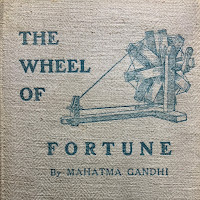 Tomorrow marks what would have been Mohandas Karamchad Gandhi's 152nd birthday. In India, October 2nd is called "Gandhi Jayanti" and is one of the country's three national holidays. In 2007, the United Nations General Assembly established the date as the International Day of Non-Violence. For most of the world, Gandhi's name has become synonymous with a philosophy of non-violent resistance and, in most popular images of him, he is inevitably clad in nothing but a humble loincloth, shawl, and eyeglasses.
Tomorrow marks what would have been Mohandas Karamchad Gandhi's 152nd birthday. In India, October 2nd is called "Gandhi Jayanti" and is one of the country's three national holidays. In 2007, the United Nations General Assembly established the date as the International Day of Non-Violence. For most of the world, Gandhi's name has become synonymous with a philosophy of non-violent resistance and, in most popular images of him, he is inevitably clad in nothing but a humble loincloth, shawl, and eyeglasses.However, for those of us who were born decades after his assassination in 1948, it may come as a surprise to know that Gandhi did not openly adopt this iconic wardrobe until he was 52 years of age. He also had lived half of his life abroad in both England and South Africa before returning to his homeland at the age of 45. He had gained a reputation among his countryman as a nationalist and community organizer because of his advocacy for South Africa's Indian population. Soon after his return, Gandhi assumed leadership of the Indian National Congress and immediately began to challenge British rule.
Gandhi adopted the loincloth and shawl as a means of connecting with Indians living in poverty; the clothing was woven from yarn made on a traditional Indian spinning wheel, called a charkha. The spinning wheel became central to Gandhi's struggle for national emancipation as a symbol of self-sufficiency as well as a practical method by which to boycott British goods and create a sense of national identity. He published a book titled "The Wheel of Fortune" in 1922 that outlined this philosophy by encouraging Indian people to spin their own clothing as a means of protest. Fittingly, the book is bound in Khadi, the cloth produced by traditional Indian spinning and weaving.
To see a rare first edition of this book, come to Rauner and ask to see Rare Book HC435 .G3.